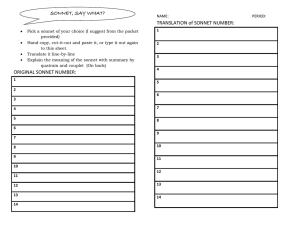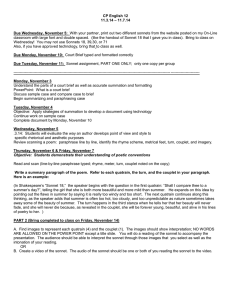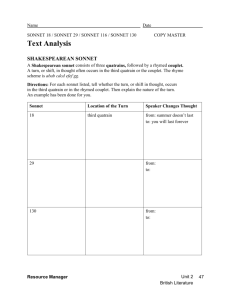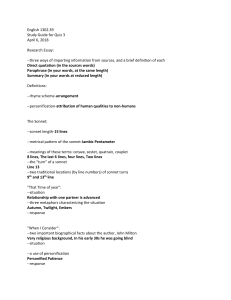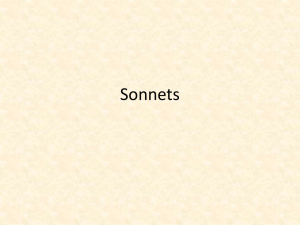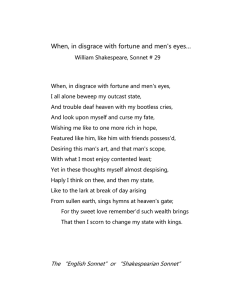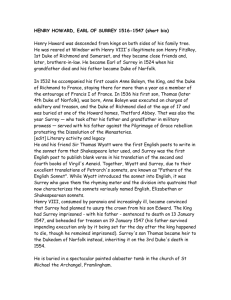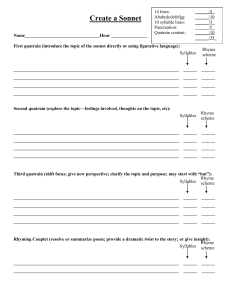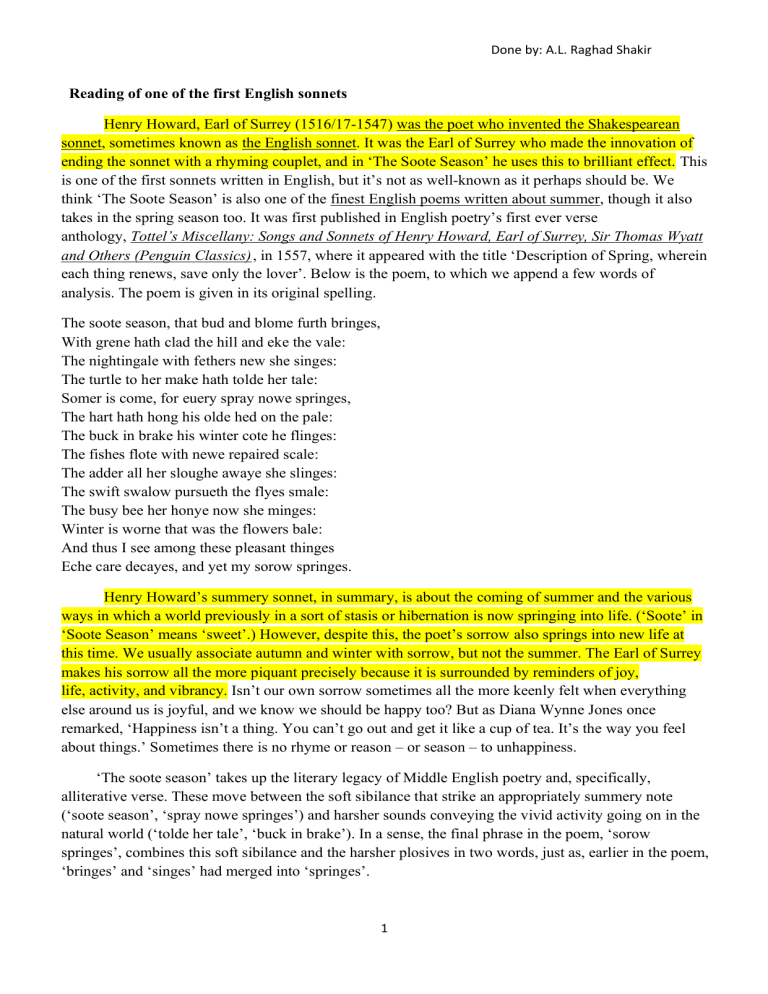
Done by: A.L. Raghad Shakir
Reading of one of the first English sonnets
Henry Howard, Earl of Surrey (1516/17-1547) was the poet who invented the Shakespearean
sonnet, sometimes known as the English sonnet. It was the Earl of Surrey who made the innovation of
ending the sonnet with a rhyming couplet, and in ‘The Soote Season’ he uses this to brilliant effect. This
is one of the first sonnets written in English, but it’s not as well-known as it perhaps should be. We
think ‘The Soote Season’ is also one of the finest English poems written about summer, though it also
takes in the spring season too. It was first published in English poetry’s first ever verse
anthology, Tottel’s Miscellany: Songs and Sonnets of Henry Howard, Earl of Surrey, Sir Thomas Wyatt
and Others (Penguin Classics), in 1557, where it appeared with the title ‘Description of Spring, wherein
each thing renews, save only the lover’. Below is the poem, to which we append a few words of
analysis. The poem is given in its original spelling.
The soote season, that bud and blome furth bringes,
With grene hath clad the hill and eke the vale:
The nightingale with fethers new she singes:
The turtle to her make hath tolde her tale:
Somer is come, for euery spray nowe springes,
The hart hath hong his olde hed on the pale:
The buck in brake his winter cote he flinges:
The fishes flote with newe repaired scale:
The adder all her sloughe awaye she slinges:
The swift swalow pursueth the flyes smale:
The busy bee her honye now she minges:
Winter is worne that was the flowers bale:
And thus I see among these pleasant thinges
Eche care decayes, and yet my sorow springes.
Henry Howard’s summery sonnet, in summary, is about the coming of summer and the various
ways in which a world previously in a sort of stasis or hibernation is now springing into life. (‘Soote’ in
‘Soote Season’ means ‘sweet’.) However, despite this, the poet’s sorrow also springs into new life at
this time. We usually associate autumn and winter with sorrow, but not the summer. The Earl of Surrey
makes his sorrow all the more piquant precisely because it is surrounded by reminders of joy,
life, activity, and vibrancy. Isn’t our own sorrow sometimes all the more keenly felt when everything
else around us is joyful, and we know we should be happy too? But as Diana Wynne Jones once
remarked, ‘Happiness isn’t a thing. You can’t go out and get it like a cup of tea. It’s the way you feel
about things.’ Sometimes there is no rhyme or reason – or season – to unhappiness.
‘The soote season’ takes up the literary legacy of Middle English poetry and, specifically,
alliterative verse. These move between the soft sibilance that strike an appropriately summery note
(‘soote season’, ‘spray nowe springes’) and harsher sounds conveying the vivid activity going on in the
natural world (‘tolde her tale’, ‘buck in brake’). In a sense, the final phrase in the poem, ‘sorow
springes’, combines this soft sibilance and the harsher plosives in two words, just as, earlier in the poem,
‘bringes’ and ‘singes’ had merged into ‘springes’.
1
Done by: A.L. Raghad Shakir
That last word, ‘springes’, is especially poignant, given the seasonal focus of the poem: spring and
summer should not give rise to sorrow. And it is all the more arresting given that it comes hot on the
heels of many previous ‘inge’ rhymes: bringes, singes, flinges, slinges, thinges, and – indeed – springes:
‘Somer is come, for euery spray nowe springes’.
‘The soote season’ is not only one of the first English sonnets written in English; it was written by the
very man who invented the sonnet form that Shakespeare would later put his indelible stamp on. But
Henry Howard, Earl of Surrey is not as celebrated as the Bard. Even a preliminary analysis of ‘The
soote season’ shows, however, that he didn’t simply prepare the way for Shakespeare: he wrote a
powerfully affecting and technically accomplished sonnet in his own right.
Analysis:
Two interesting elements stand out in Henry Howard, Earl of Surrey's sonnet. Surrey constructs the
sonnet in three quatrains and an ending couplet--a structure later borrowed by Spenser and Shakespeare.
Surrey's rhyme scheme though is abababababab aa. In addition, he employs the rhetorical word scheme
technique of hyperbaton, the modification of expected word order syntax. In each quatrain, there are
instances of general hyperbaton syntax of Subject Object Verb (SOV) instead of the expected Subject
Verb Object (SV/O/C). An example is "The nightingale with feathers new (S) she (O) sings (V)." The
expected syntax would be: "The nightingale with new feathers (S) sings (V) [no (O)]. Even "feathers
new" is a special class of hyperbaton called anastrophe in which the normal order of Adjective + Noun
is inverted to Noun + Adjective as in feathers (N) + new (Adj).
Some of these hyperbatonized sentences are quite intricate, for example: "Winter is worn that was
the flower's bale." The basic syntax of the sentence as written by Surrey is SVC (Complement to the
Subject), yet the noun modifying that-clause has been relocated to a position following the Complement
"worn." The substituting paraphrase of this sentence is: "Winter that now is worn (S) was (V) the
flower's bale [i.e., destroyer] (C)." The ending lines in the couplet are in the expected SV/O/C pattern,
e.g., "and yet my sorrow (S) springs (V)."
This sad sonnet employs the paradox of the Petrarchan sonnet model. The quatrains talk about the
features of the seasons. Instead of one Petrarchan volta at line 9 to change, or turn, the theme of the
subject, there are two voltas (an innovation Spenser and Shakespeare later used). The first quatrain
describes the pleasures of spring: "bud and bloom forth brings." The first volta at line 5 turns
to summer's pleasures: "Summer is come." The second volta at line 9 turns the third quatrain to autumn,
when the honey bee "mings," or remembers, having made honey, and to "the flower's bale," winter, that
overwhelmed the flowers but now itself is "worn." The sorrow and paradox come in the second line of
the couplet where we discover that after watching the pleasantries of the changing seasons for a year, the
poetic speaker's sorrow wells up like a spring:
And thus I see among these pleasant things
Each care decays, and yet my sorrow springs.
2
Done by: A.L. Raghad Shakir
What is it about the language of Surrey's "The soote season" that is of special interest?
The language of Surrey's sonnet, "Description of Spring," or "The soote season," is most interesting
because he imitates a dialect from a much earlier time in London's history. England had (indeed has)
many dialects. The one that came to dominate was the dialect of London. Geoffrey Chaucer, writing in
the latter part of the 1300s, spoke and wrote in the Middle English version of the London dialect.
Surrey, who wrote in the early 1500s, was a Londoner, thus spoke and wrote in the much later London
dialect of contemporaries Shakespeare, Edmund Spenser and Sir Philip Sidney.
Though writing about 150 years after Chaucer, during an era when the London dialect reflected
vast linguistic change, Surrey imitated Chaucer's earlier dialect in this sonnet (and others). Since many
words of Chaucer's dialect had grown obsolete or undergone changes in pronunciation and spelling, it
was a challenge for Surrey to learn and use the earlier dialect. Examples of this challenge are the words
{soote, eke, make, brake, mings and bale}, these words would have been known to Surrey (as to us) as
{sweet, also, mate, antlers, mixes and bane).
The buck in brake his winter coat he slings ;
The fishes flete with new repairèd scale ;
The adder all her slough away she slings ;
The swift swallow pursueth the fliës smale ;
The busy bee her honey now she mings ;
Winter is worn that was the flowers' bale.
What is an explanation of "Description of Spring" by Henry Howard, the Earl of
Surrey?
DESCRIPTION OF SPRING,
WHEREIN EVERY THING RENEWS, SAVE ONLY THE LOVER.
The explanation of "Description of Spring is that it is a love sonnet of unrequited love summed up in
the rhyming couplet of lines 13 and 14:
And thus I see among these pleasant things
Each care decays, and yet my sorrow springs !
The message is that all things are renewed in spring except for the love of his lost beloved.
Surrey, Henry Howard, earl of Surrey, lists things in nature that throw off winter's oppression and
embrace spring's renewal. Some of these are the buck (deer) and adder (snake), the flower and bee, the
nightingale and the hills. He ends by saying that his beloved has not cast off the oppression of winter nor
embraced renewal of spring: she still does not like him and still rejects him.
Surrey experimented with Petrachan sonnet form. The structure of this sonnet is 14 lines comprised of
one opening quatrain followed by a octet and concluded with a rhyming couplet. The volta is line five.
To restate this, the first four lines form a quatrain devoted to the topic of the coming of spring: "The
3
Done by: A.L. Raghad Shakir
soote season, that bud and bloom forth brings". The next eight lines form an octet devoted to the topic of
nature's summer changes: "Summer is come, ... / The hart hath hung his old head [antlers] ...." The
switch from the first topic to the second occurs at line 5; the switch is called the volta or the "turn." The
rhyme scheme is a consistent abab / abababab with an aa couplet.
There are two things to note. The first is that spring in England can be very damp and cold, thus events
that some of us from warmer climes associate with spring are delayed until summer itself, for example,
"The buck in brake his winter coat he slings ;". The second is that, although Surrey was a contemporary
of Shakespeare, Spenser and Sidney, Surrey borrows a gentler form of Chaucer's much earlier Middle
English, thus many words need defining as their meanings are obscured. Luminarium.com provides a
very useful gloss of these words.
1 [soote] Sweet.
2 [eke] Also.
3 [turtle] turtledove.
4 [make] Mate.
5 [spray] Sprig; spray of flowers.
6 [hart] Deer.
7 [head on the pale] last year's antlers [discarded].
8 [pale] Fencepost; picket.
9 [brake] Bracken; thicket.
10 [flete] Fleet; fast.
11 [smale] Small.
12 [mings] mixes.
13 [worn] Worn out; over.
14 [bale] Bane; destruction.
15 [care] Worry; worrisome thing. (Anniina Jokinen)
What is the theme of "Description of Spring"?
"Description of Spring" by Henry Howard, Earl of Surrey (1516–47) is written in the form of an
English, or Shakespearean, sonnet, consisting of three open quatrains followed by a couplet. As with
most sonnets, it is characterized by a "turn" or striking and abrupt reversal between the third quatrain
and the final couplet.
The first twelve lines, as the title suggests, are a description of the way life renews itself in the spring.
Several such renewals are described, including the fresh plumage of the nightingale and the song of the
turtledove. Fish, deer, snakes, and bees all participate in the joyous new life that emerges at the end of
winter.
The exception to this is the narrator of the poem, who despite being surrounded by and appreciating the
spring, and seeing it as a time of joy when cares are shed, nonetheless himself remains sorrowful.
4
Done by: A.L. Raghad Shakir
The theme of Henry Howard's poem "Description of Spring" is change. The speaker of the poem is
reflecting on the spring which is to come.
Given that the buck flings his winter coat, "his winter coat he flings", the poem recognizes the fact that
spring is just around the corner. Not only has the buck recognized the coming of spring, others have as
well: the fish are changing, "new repaired scale", the adder slings away her sloth, and the bee is
beginning to make her honey.
In the end, the theme is detailed through the passing of winter and the promise of summer. The season in
the middle, spring, is described so as to speak to the promise of new life and new outlooks.
The soote season, that bud and bloom forth brings,
With green hath clad the hill and eke the vale;
The nightingale with feathers new she sings,
The turtle to her make hath told her tale.
Henry Howard started to introduce the countryside of England in beautiful image. He chooses a
beautiful line to begin his sonnet to give some hope to the readers and the listeners. He started
describing the changing that happening during spring the flora and fauna of nature change for the better.
He chose the spring season because he knows the sorrow of his people, so he did not want to shock them
with scary image. He wants to give them a hope. In line 3 he moves on drawing an image of the bird
which “nightingale” changing his feather .it is ironic to use the “nightingale” it is a symbol of ugliness.
once it use by any poet it is give a gloomy atmosphere but, Henry Howard very cleverly use it at first, in
a happy image by telling us that the feathers changed and changing means something good. However, he
is using it again in ironic way reflecting his own age, England is improving but, in wrong way and his
people suffering from this changing. First quatrain started contrast between the personal life of the
speaker and the external world of nature. in line 3 Henry Howard also use a new structure technique
which is “Anastrophe ”is most often a synonym for hyperbaton, he play of the order of words to make
the poem more musical (Volta)
He start to describe another season which is summer and it has own good side in which is give us
warmth and springs “Springs” here means “encourages new growth”. He uses metaphors, when he refers
to the hart hanging his old head, or the buck flinging in his winter coat. Henry Howard indirectly calling
his people to change to the better he ask them to change them minds, the way they think and ask them to
enjoy the kind of flourished that England people is having, as country when it conquered another
country they will take their good and their money.in line 3 he personification a kind of animal in which
he remove the skin and wearing another one, he says to his people let us remove the ugly feature we
have in our faces, let us remove it and live a simple happy life . also in line 4 he goes on with changing
of fishes skin and everything seems to change weather in spring or summer some or the changing for
good and some of it for bad. The changing is happening any way.
5
Done by: A.L. Raghad Shakir
The adder all her slough away she slings,
The swift swallow pursueth the flyës smale,
The busy bee her honey now she mings Winter
is worn that was the flowers' bale.(volta)
He describing now autumn season in a beautiful way that things in autumn also change and he
gives image of ugly thing which after a while it is changing to beautiful things. in line 3 there is indirect
message for his people to work hard like a bee and he want his people to stand the bees as a symbol for
them and working as a group their hearts together and working in harmony and at that time people in the
court did not working in harmony. They have own fight and clashes, he refer indirectly to the roses war.
He asks the court people to work in harmony. Working in harmony will helps to make their society
stronger. In line 4 the full stop is indicating to shifting to a new idea. He beautifully ended the last
quatrain that winter is come and it covered everything, everything went down to it cave or house waiting
to spring coming back. There is circle of life is presenting in Henry Howard poem. He wants us to learn
from nature and the cycle of nature it is the same of the cycle of human being. Most of the images Henry
Howard draws it is happy and good one, there is a changing but it is to better for everyone not just for a
particular part. it is indirect technique done by Henry Howard which later on adopting in the
preromantic and the romantic, referring back to nature .he reflecting to the problem of clashes between
the religion in early 16th century and the church people at that time so involve in religion they almost
became a blind to understand the kind of changing going around them and as a result they force their
people to do something not suitable of that time that what led the protonate to raise. He says the
harmony of nature is our purpose to do in our own life.
Each care decays, and yet my sorrow springs.
This a beautiful couplet chosen by Henry Howard to end his own sonnet in which he sum up the
meaning of the whole sonnet that he sorrow from the loss of his beloved. In the first line the using of “I”
it is refer to personal note which is a technique used by Henry Howard, so in the last two lines he
shifting to talking about his personal life. He indicated the pleasure in first line of the couplet everything
is changing to the better. However the kind of springs he see whether in summer or spring it changing
but he feelings sorrow, it is keep remind him to his beloved . there is a paradox in this couplet and one
of the important things about Thomas Wyatt and Henry Howard that they contributed different
techniques to literature and one of the technique that Henry Howard brought is the paradox of the
Petrarchan sonnet in which he reflect his personal feelings and link it with the main theme of whole
sonnet.
The themes of the poem:
1. The sorrow of losing his beloved.
2. The meditation of his own personal life with the natural world.
The structure of the poem:
6
Done by: A.L. Raghad Shakir
It is an English sonnet divided into 3 quatrain and couplet. The rhyme scheme is A B A B.. The
couplet is AA. Henry Howard also use a new structure technique which is “Anastrophe” is most often a
synonym for hyperbaton, he play of the order of words to make the poem more musical. He also use the
paradox in his sonnet. It a sad tone.
7
